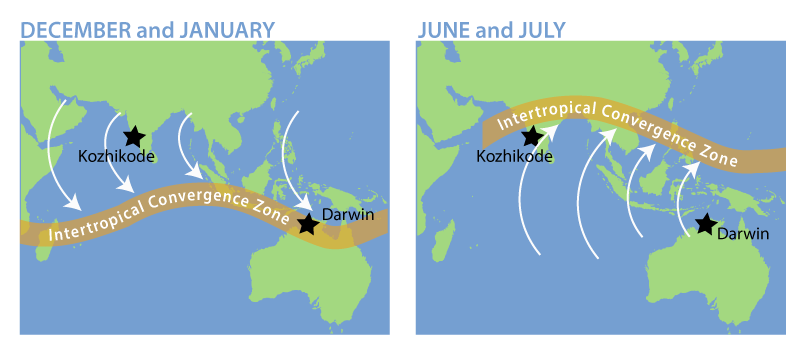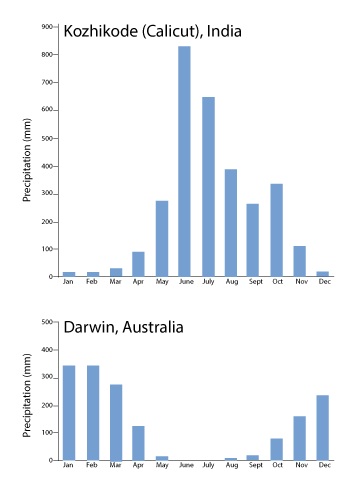“The monsoon winds have formally arrived in the city,” Mumbai Regional Meteorological Centre’s director-general V.K. Rajeev told the Indian press on Friday June 12, 2015, after a full night of rain.
He referred to winds even though people cared more about the rains that had just started. That’s because monsoon rains are controlled by the wind and, in general, by the way air moves through the tropical atmosphere, which changes dramatically at the beginning and end of every summer.
There’s a pattern to the wind.
Air moves through the tropical atmosphere in a pattern called the Hadley Circulation – warm air rises near the equator, flows toward the poles, and then descends back toward the Earth’s surface in the subtropics. The air flows along Earth’s surface from the subtropics toward the equator and then the loop starts all over again.

Sunlight, and the energy it brings to Earth, is the driving force behind the Hadley Circulation. Sunlight heats land and ocean surfaces near the equator. The warmed surface releases energy into the atmosphere, in the form of heat and evaporated water. Air that was warmed at the equator, and the water vapor it holds, rises and spreads out in the upper atmosphere, approximately 10-15 kilometers above the Earth’s surface. As it flows toward the poles, this air cools and drops down toward the surface of the Earth in the subtropics, near 30 degrees latitude north or south of the equator. As air rises near the equator and then flows poleward, it leaves an area of fewer air molecules at the equator. This is a region of low pressure because there is a smaller mass of air left over the equator. Air from the subtopics, north and south of the equator, flows in to fill the space, completing the loop of Hadley Circulation. The area near the equator with low pressure and converging, rising winds is called the Intertropical Convergence Zone (ITCZ). Water vapor condenses as air rises and cools in the ITCZ, forming clouds and falling as rain. The ITCZ can be seen from space as a band of clouds around the planet. This is where monsoon rainfall occurs.
If the Earth were not rotating, winds would blow directly towards the Intertropical Convergence Zone from the north and south. But the Earth is rotating – making a full turn on its axis each day – which turns the wind to the right in the Northern Hemisphere and to the left in the Southern Hemisphere. This means that air flowing toward the equator near Earth’s surface also flows toward the west, and makes up what we call the “trade winds”, which were important for global trade back in the days when goods were transported between continents by sailing ships. The effect of Earth’s rotation on the winds is called the Coriolis effect or Coriolis force. It also affects the movement of ocean currents and the direction of rotation in hurricanes. Motions that span hundreds to thousands of miles feel the Coriolis force. It does not impact smaller scale phenomena like tornadoes. (And contrary to legend, the direction that water spins in a flushing toilet is due to toilet design, as toilets are much too small to feel the Coriolis force.)
The way the trade winds turned to the west on their way to the equator was of great interest to George Hadley, an 18th Century British lawyer who dabbled in meteorology. He proposed that it was the spin of the Earth that caused the winds to turn as they blew towards the equator. He produced what was essentially the first global theory of atmospheric circulation. Over the years other scientists have refined and further developed these ideas, but Hadley did get some of the basics correct. Today, the Hadley Circulation in the tropics is named after George Hadley.
The Hadley Circulation doesn’t stay in the same place year-round, but varies with the seasons. This is the key to understanding why many tropical regions around the world have patterns of wet monsoon summers and dry winters. The seasonal changes in the Hadley Circulation create the world’s monsoons.
Winds change through the year.
During December and January, the Southern Hemisphere is heated more strongly by the sun than the Northern Hemisphere, so the hottest air – the air that rises in the ITCZ – is found a little south of the equator. Winds from the Northern Hemisphere blow across the equator towards the ITCZ. During June and July, the Northern Hemisphere is heated more strongly by the sun, so the ITCZ and its rising hot air lie a little north of the equator and winds blow from the Southern Hemisphere across the equator to reach the ITCZ in the Northern Hemisphere.
As the ITCZ changes location through the year, the winds and rains and the location of monsoon wet weather changes, too.

Remember that the Coriolis force changes direction on the equator: It turns winds toward the right in the Northern Hemisphere and to the left in the Southern Hemisphere. So when air crosses the equator as it flows from the cold winter hemisphere toward the ITCZ in the summer hemisphere, it experiences a change in the Coriolis force. This causes the trade winds to reverse direction and blow toward the west in the winter hemisphere and to the east in the summer hemisphere. This seasonal reversal of the winds was historically very important for trade between Africa and Asia; ships would sail from Asia to Africa in winter and then undertake their return voyage when the summer monsoon changed the wind from westward to eastward.

The summer monsoon is what people often think of as monsoon conditions: large amounts of rain. But the winter monsoon, where dry conditions prevail, is part of the pattern too. During winter, air descends over tropical continents as the part of the Hadley Circulation that is outside of the ITCZ. Descending air causes high pressure, and makes clouds and rain uncommon. The dry conditions during winter can even lead to drought if they are too intense or persist for too long.
Monsoons are affected by geography.
Geography affects the amount of rainfall that an area receives as the ITCZ moves through the seasons. For example, during Northern Hemisphere winter the ITCZ is south of the equator and monsoon rains fall in northern Australia. Low-level winds blow south towards the ITCZ, picking up moisture as they move over the warm, tropical ocean. Meanwhile in India, dry air descending over land means there is little precipitation.
During Northern Hemisphere summer, the ITCZ is north of the equator and monsoon rains fall in India and other parts of south Asia as winds blow north from the tropical ocean to the land, while northern Australia experiences very dry conditions as air descends.

The location of monsoon rainfall is affected by the fact that land can’t hold onto heat as well as the ocean. When intense summer sunlight hits land, its energy is absorbed and transferred quickly back into the atmosphere. When summer sunlight hits the ocean, the sun’s energy is held by water and can be mixed downward and stored tens to hundreds of feet below the surface. This means that, in summer, air over land is heated more than air over ocean, which shifts the ITCZ toward land regions. In regions where continents lie north or south of the equator, as in Asia and Australia, this causes the ITCZ to shift farther off the equator during the summer season.
What affects the amount of rain?
There is year-to-year variation in the amount of monsoon rainfall during summer. For example, researchers have found that during El Niño conditions, when the Pacific Ocean is particularly warm near the equator, there is typically less rainfall during the summer monsoon in India. During La Niña conditions, when the Pacific Ocean is cool, there is more rain during the summer monsoon in India. While this is a general pattern, it cannot be used to indicate exactly how much rain will fall in India in any particular summer. In fact, the strongest El Niño event in the 20th Century (1997-1998) had little effect on the Indian monsoon. So there must be other influences on the amount of rainfall, too. This is an area of active research.
Climate change may be changing monsoons.
According to most computer simulations of Earth’s climate over the next 50-100 years, there will be an increase in rainfall in most monsoon regions as climate warms due to the rising levels of atmospheric greenhouse gases such as carbon dioxide. Rains will likely increase in wet regions as climate warms because warm air can hold more water; if the winds do not change, more water vapor in the atmosphere will produce more rain in the ITCZ. Over ocean, where there is abundant water supply for the atmosphere, this is quite likely, but it is less clear how the amount of rain may change over land as climate warms. Whether or not winds will change enough to have a large effect on the rainfall is also unclear. During the dry season, land is expected to become drier because evaporation from land will increase in a warmer climate.
At the same time that rainfall is changing due to global climate change, natural year-to-year variability is happening as well. Other changes to the amount of rainfall may be caused by air pollution (such as tiny particles released as coal, oil, and gas are burned). The amount of monsoon rain that falls each year is highly variable, according to records of rain in India collected since the 1880s. In parts of India monsoon rainfall has decreased some since 1950. Meanwhile, in the Philippines and other areas of the western North Pacific, the amount of monsoon rain has increased. Weak monsoon rains produced drought and famine over large parts of Africa in the 1970s and 1980s, but the West African monsoon rains have recovered somewhat since then. So there is evidence that monsoons are changing, but researchers are still investigating how the amount of monsoon rainfall will be affected by climate change in the future.
Explore more:
i like this website…
Climate change may be changing monsoons.
i like this site very useful and climate change is changing the planet and one day the ocean might cover most of the planet but that shouldn’t happen for a couple million years we will see in the future.